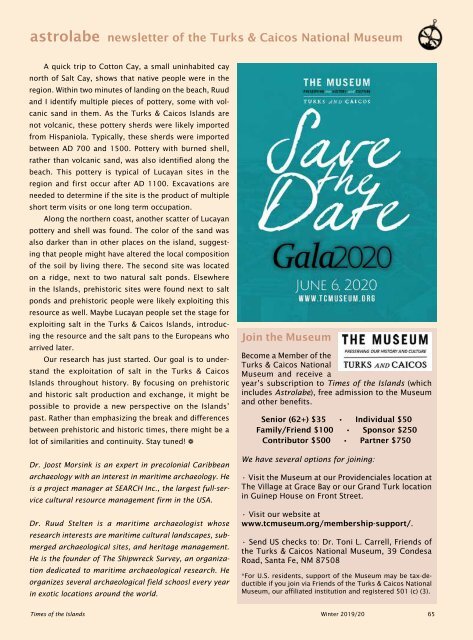Times of the Islands Winter 2019/20
Presents the "soul of the Turks & Caicos Islands" with in-depth features about local people, culture, history, environment, businesses, resorts, restaurants and activities.
Presents the "soul of the Turks & Caicos Islands" with in-depth features about local people, culture, history, environment, businesses, resorts, restaurants and activities.
You also want an ePaper? Increase the reach of your titles
YUMPU automatically turns print PDFs into web optimized ePapers that Google loves.
astrolabe newsletter <strong>of</strong> <strong>the</strong> Turks & Caicos National Museum<br />
A quick trip to Cotton Cay, a small uninhabited cay<br />
north <strong>of</strong> Salt Cay, shows that native people were in <strong>the</strong><br />
region. Within two minutes <strong>of</strong> landing on <strong>the</strong> beach, Ruud<br />
and I identify multiple pieces <strong>of</strong> pottery, some with volcanic<br />
sand in <strong>the</strong>m. As <strong>the</strong> Turks & Caicos <strong>Islands</strong> are<br />
not volcanic, <strong>the</strong>se pottery sherds were likely imported<br />
from Hispaniola. Typically, <strong>the</strong>se sherds were imported<br />
between AD 700 and 1500. Pottery with burned shell,<br />
ra<strong>the</strong>r than volcanic sand, was also identified along <strong>the</strong><br />
beach. This pottery is typical <strong>of</strong> Lucayan sites in <strong>the</strong><br />
region and first occur after AD 1100. Excavations are<br />
needed to determine if <strong>the</strong> site is <strong>the</strong> product <strong>of</strong> multiple<br />
short term visits or one long term occupation.<br />
Along <strong>the</strong> nor<strong>the</strong>rn coast, ano<strong>the</strong>r scatter <strong>of</strong> Lucayan<br />
pottery and shell was found. The color <strong>of</strong> <strong>the</strong> sand was<br />
also darker than in o<strong>the</strong>r places on <strong>the</strong> island, suggesting<br />
that people might have altered <strong>the</strong> local composition<br />
<strong>of</strong> <strong>the</strong> soil by living <strong>the</strong>re. The second site was located<br />
on a ridge, next to two natural salt ponds. Elsewhere<br />
in <strong>the</strong> <strong>Islands</strong>, prehistoric sites were found next to salt<br />
ponds and prehistoric people were likely exploiting this<br />
resource as well. Maybe Lucayan people set <strong>the</strong> stage for<br />
exploiting salt in <strong>the</strong> Turks & Caicos <strong>Islands</strong>, introducing<br />
<strong>the</strong> resource and <strong>the</strong> salt pans to <strong>the</strong> Europeans who<br />
arrived later.<br />
Our research has just started. Our goal is to understand<br />
<strong>the</strong> exploitation <strong>of</strong> salt in <strong>the</strong> Turks & Caicos<br />
<strong>Islands</strong> throughout history. By focusing on prehistoric<br />
and historic salt production and exchange, it might be<br />
possible to provide a new perspective on <strong>the</strong> <strong>Islands</strong>’<br />
past. Ra<strong>the</strong>r than emphasizing <strong>the</strong> break and differences<br />
between prehistoric and historic times, <strong>the</strong>re might be a<br />
lot <strong>of</strong> similarities and continuity. Stay tuned! a<br />
Dr. Joost Morsink is an expert in precolonial Caribbean<br />
archaeology with an interest in maritime archaeology. He<br />
is a project manager at SEARCH Inc., <strong>the</strong> largest full-service<br />
cultural resource management firm in <strong>the</strong> USA.<br />
Dr. Ruud Stelten is a maritime archaeologist whose<br />
research interests are maritime cultural landscapes, submerged<br />
archaeological sites, and heritage management.<br />
He is <strong>the</strong> founder <strong>of</strong> The Shipwreck Survey, an organization<br />
dedicated to maritime archaeological research. He<br />
organizes several archaeological field schoosl every year<br />
in exotic locations around <strong>the</strong> world.<br />
Join <strong>the</strong> Museum<br />
Become a Member <strong>of</strong> <strong>the</strong><br />
Turks & Caicos National<br />
Museum and receive a<br />
year’s subscription to <strong>Times</strong> <strong>of</strong> <strong>the</strong> <strong>Islands</strong> (which<br />
includes Astrolabe), free admission to <strong>the</strong> Museum<br />
and o<strong>the</strong>r benefits.<br />
Senior (62+) $35 • Individual $50<br />
Family/Friend $100 • Sponsor $250<br />
Contributor $500 • Partner $750<br />
We have several options for joining:<br />
• Visit <strong>the</strong> Museum at our Providenciales location at<br />
The Village at Grace Bay or our Grand Turk location<br />
in Guinep House on Front Street.<br />
• Visit our website at<br />
www.tcmuseum.org/membership-support/.<br />
• Send US checks to: Dr. Toni L. Carrell, Friends <strong>of</strong><br />
<strong>the</strong> Turks & Caicos National Museum, 39 Condesa<br />
Road, Santa Fe, NM 87508<br />
*For U.S. residents, support <strong>of</strong> <strong>the</strong> Museum may be tax-deductible<br />
if you join via Friends <strong>of</strong> <strong>the</strong> Turks & Caicos National<br />
Museum, our affiliated institution and registered 501 (c) (3).<br />
<strong>Times</strong> <strong>of</strong> <strong>the</strong> <strong>Islands</strong> <strong>Winter</strong> <strong><strong>20</strong>19</strong>/<strong>20</strong> 65

















